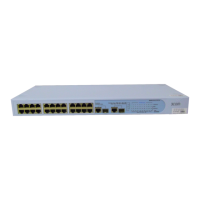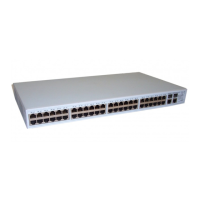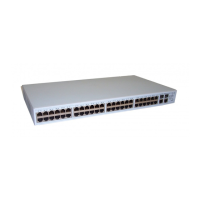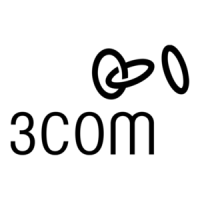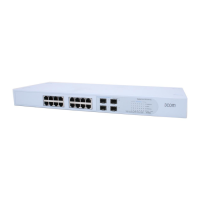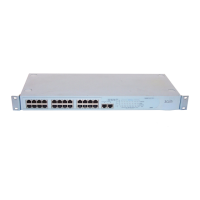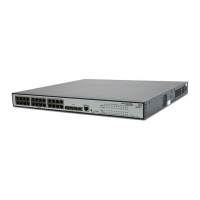Do you have a question about the 3Com Baseline 2226 Plus and is the answer not in the manual?
Lists icons and their meanings used in the guide.
Instructions for submitting feedback on the documentation.
Information on how to register the product online.
Provides an overview of the 3Com Baseline Switch 2226 Plus features.
Details the 24 auto-negotiating 10/100 Mbps ports and 2 Gigabit combo ports.
Explains how ports automatically sense MDI/MDIX connections for easy cabling.
Describes how ports automatically determine speed and duplex mode.
Details the functionality of the two Gigabit combo ports supporting SFP transceivers.
Details the physical layout and components of the switch, including front and rear panels.
Lists the items included in the switch package.
Provides essential safety information and warnings before starting the installation.
Offers guidance on selecting an appropriate location for the switch.
Explains options for mounting the switch in a rack or placing it free-standing.
Details the procedure for using the provided mounting kit for rack installation.
Provides guidelines for stacking multiple switch units safely.
Instructs on connecting the power cord and powering on the switch.
Explains how to install and use SFP transceivers in the switch's SFP slots.
Guides on performing visual checks to ensure the switch is operating correctly.
Lists prerequisites for accessing the switch's web interface.
Explains how to launch and use the 3Com Discovery application.
Details the process of logging into the switch's web interface using default credentials.
Describes the layout of the web interface, including menus and tabs.
Explains how to access the web interface directly if the IP address is known.
Outlines when web interface access is needed for configuration tasks.
Describes how to view basic switch settings and component versions.
Lists the main administration items available in the switch's menu.
Guides on configuring the IP address settings for the switch.
Details how to save the switch's current configuration settings.
Explains how to load previously saved configuration settings.
Guides on how to install new system firmware releases for the switch.
Describes how to reset the switch to its factory default settings.
Explains how to restart the switch, similar to power cycling.
Details how to manage user accounts and secure access to the web interface.
Introduces SNMP for network device management and monitoring.
Explains how to create and manage Virtual LANs to segment the network.
Introduces Spanning Tree Protocol for fault tolerance and loop detection.
Explains IGMP snooping for optimizing multicast traffic.
Details how to configure broadcast storm control and threshold limits.
Guides on configuring port speed/duplex, flow control, link aggregation, and mirroring.
Explains how to monitor network traffic by mirroring ports.
Describes how to view port statistics, including packet counts and errors.
Guides on configuring Quality of Service settings for Voice over IP traffic.
Covers configuration of RADIUS Client and 802.1X settings for network access control.
Covers displaying address table information and performing cable diagnostics.
Provides instructions on resetting the switch to its original factory settings.
Explains how to regain access if the web interface password is forgotten.
Guides on how to find the IP address if it's forgotten.
Lists common LED issues and provides troubleshooting steps.
Offers advice on what to do if problems remain unresolved.
Explains the importance and process of product registration for warranty benefits.
Details additional services offered by 3Com to enhance support and warranty.
Points to online resources for troubleshooting, including the 3Com Knowledgebase.
Guides on accessing software updates and maintenance releases.
Provides information on obtaining telephone support and initiating repair services.
Lists contact information for technical support and repair services by region.
Lists the standards to which the Baseline Switch 2226 Plus has been designed.
Provides physical specifications like width, depth, height, weight, and mounting options.
Details electrical specifications including power inlet, voltage, and consumption.
Refers to the separate safety and regulatory information manual for detailed safety guidelines.
Defines the IEEE 802.3ab specification for Gigabit Ethernet over twisted-pair cable.
Explains the process of automatic speed and duplex mode configuration between devices.
Defines Dynamic Host Configuration Protocol for automatic IP address assignment.
Defines Ethernet as a LAN specification using CSMA/CD.
Defines an IP Address as a unique identifier for a network device.
Defines Local Area Network as a network of end stations in a small geographic area.
Defines Media Access Control Address as the hardware or physical address of a network device.
Defines a Switch as a device interconnecting LANs to form a logical LAN.
Defines TCP/IP as a suite of protocols for network interconnection.
Defines Virtual LAN as a logical workgroup with no physical barriers.
States compliance with FCC rules for Class A digital devices and potential interference.
Declares compliance with European Low Voltage and EMC Directives.
Declares compliance with Canadian Interference-Causing Equipment Regulations.
Lists icons and their meanings used in the guide.
Instructions for submitting feedback on the documentation.
Information on how to register the product online.
Provides an overview of the 3Com Baseline Switch 2226 Plus features.
Details the 24 auto-negotiating 10/100 Mbps ports and 2 Gigabit combo ports.
Explains how ports automatically sense MDI/MDIX connections for easy cabling.
Describes how ports automatically determine speed and duplex mode.
Details the functionality of the two Gigabit combo ports supporting SFP transceivers.
Details the physical layout and components of the switch, including front and rear panels.
Lists the items included in the switch package.
Provides essential safety information and warnings before starting the installation.
Offers guidance on selecting an appropriate location for the switch.
Explains options for mounting the switch in a rack or placing it free-standing.
Details the procedure for using the provided mounting kit for rack installation.
Provides guidelines for stacking multiple switch units safely.
Instructs on connecting the power cord and powering on the switch.
Explains how to install and use SFP transceivers in the switch's SFP slots.
Guides on performing visual checks to ensure the switch is operating correctly.
Lists prerequisites for accessing the switch's web interface.
Explains how to launch and use the 3Com Discovery application.
Details the process of logging into the switch's web interface using default credentials.
Describes the layout of the web interface, including menus and tabs.
Explains how to access the web interface directly if the IP address is known.
Outlines when web interface access is needed for configuration tasks.
Describes how to view basic switch settings and component versions.
Lists the main administration items available in the switch's menu.
Guides on configuring the IP address settings for the switch.
Details how to save the switch's current configuration settings.
Explains how to load previously saved configuration settings.
Guides on how to install new system firmware releases for the switch.
Describes how to reset the switch to its factory default settings.
Explains how to restart the switch, similar to power cycling.
Details how to manage user accounts and secure access to the web interface.
Introduces SNMP for network device management and monitoring.
Explains how to create and manage Virtual LANs to segment the network.
Introduces Spanning Tree Protocol for fault tolerance and loop detection.
Explains IGMP snooping for optimizing multicast traffic.
Details how to configure broadcast storm control and threshold limits.
Guides on configuring port speed/duplex, flow control, link aggregation, and mirroring.
Explains how to monitor network traffic by mirroring ports.
Describes how to view port statistics, including packet counts and errors.
Guides on configuring Quality of Service settings for Voice over IP traffic.
Covers configuration of RADIUS Client and 802.1X settings for network access control.
Covers displaying address table information and performing cable diagnostics.
Provides instructions on resetting the switch to its original factory settings.
Explains how to regain access if the web interface password is forgotten.
Guides on how to find the IP address if it's forgotten.
Lists common LED issues and provides troubleshooting steps.
Offers advice on what to do if problems remain unresolved.
Explains the importance and process of product registration for warranty benefits.
Details additional services offered by 3Com to enhance support and warranty.
Points to online resources for troubleshooting, including the 3Com Knowledgebase.
Guides on accessing software updates and maintenance releases.
Provides information on obtaining telephone support and initiating repair services.
Lists contact information for technical support and repair services by region.
Lists the standards to which the Baseline Switch 2226 Plus has been designed.
Provides physical specifications like width, depth, height, weight, and mounting options.
Details electrical specifications including power inlet, voltage, and consumption.
Refers to the separate safety and regulatory information manual for detailed safety guidelines.
Defines the IEEE 802.3ab specification for Gigabit Ethernet over twisted-pair cable.
Explains the process of automatic speed and duplex mode configuration between devices.
Defines Dynamic Host Configuration Protocol for automatic IP address assignment.
Defines Ethernet as a LAN specification using CSMA/CD.
Defines an IP Address as a unique identifier for a network device.
Defines Local Area Network as a network of end stations in a small geographic area.
Defines Media Access Control Address as the hardware or physical address of a network device.
Defines a Switch as a device interconnecting LANs to form a logical LAN.
Defines TCP/IP as a suite of protocols for network interconnection.
Defines Virtual LAN as a logical workgroup with no physical barriers.
States compliance with FCC rules for Class A digital devices and potential interference.
Declares compliance with European Low Voltage and EMC Directives.
Declares compliance with Canadian Interference-Causing Equipment Regulations.
| Switching Capacity | 8.8 Gbps |
|---|---|
| Forwarding Rate | 6.6 Mpps |
| VLAN Support | Yes |
| MAC Address Table Size | 8K entries |
| Operating Temperature | 0°C to 40°C |
| Operating Humidity | 10% to 90% non-condensing |
| Ports | 24 x 10/100 |
| Management | Web-based |
| Status Indicators | Link/Activity |
| Compliant Standards | IEEE 802.3, IEEE 802.3u, IEEE 802.3x, IEEE 802.1p, IEEE 802.1Q |
| Power Supply | Internal power supply |
